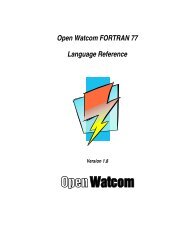Relocatable Object Module Format (OMF) Specification
Relocatable Object Module Format (OMF) Specification
Relocatable Object Module Format (OMF) Specification
Create successful ePaper yourself
Turn your PDF publications into a flip-book with our unique Google optimized e-Paper software.
<strong>Relocatable</strong> <strong>Object</strong> <strong>Module</strong> <strong>Format</strong><br />
The ordered collections are:<br />
Names<br />
Logical<br />
Segments<br />
Groups<br />
External<br />
Symbols<br />
Ordered by occurrence of LNAMES records and names within each.<br />
Referenced as a name index.<br />
Ordered by occurrence of SEGDEF records in file. Referenced as a<br />
segment index.<br />
Ordered by occurrence of GRPDEF records in file. Referenced as a<br />
group index.<br />
Ordered by occurrence of EXTDEF, COMDEF, LEXTDEF, and LCOMDEF<br />
records and symbols within each. Referenced as an external name index<br />
(in FIXUP subrecords).<br />
Numeric 2-Byte and 4-Byte Fields<br />
Words and double words (16- and 32-bit quantities, respectively) are stored in little endian byte order (lowest<br />
address is least significant).<br />
Certain records, notably SEGDEF, PUBDEF, LPUBDEF, LINNUM, LEDATA, LIDATA, FIXUPP, and MODEND,<br />
contain size, offset, and displacement values that may be 32-bit quantities for Use32 segments. The encoding is<br />
as follows:<br />
• When the least-significant bit of the record type byte is set (that is, the record type is an odd number), the<br />
numeric fields are 4 bytes.<br />
• When the least-significant bit of the record type byte is clear, the fields occupy 2 bytes. The values are zeroextended<br />
when applied to Use32 segments.<br />
Note: See the description of SEGDEF records for an explanation of Use16/Use32 segments.<br />
Order of Records<br />
The sequence in which the types of object records appear in an object module is fairly flexible in some respects.<br />
Several record types are optional, and if the type of information they carry is unnecessary, they are omitted from<br />
the object module. In addition, most object record types can occur more than once in the same object module.<br />
And because object records are variable in length, it is often possible to choose between combining information<br />
into one large record or breaking it down into several smaller records of the same type.<br />
An important constraint on the order in which object records appear is the need for some types of object records to<br />
refer to information contained in other records. Because the linker processes the records sequentially, object<br />
records containing such information must precede the records that refer to the information. For example, two<br />
types of object records, SEGDEF and GRPDEF, refer to the names contained in an LNAMES record. Thus, an<br />
LNAMES record must appear before any SEGDEF or GRPDEF records that refer to it so that the names in the<br />
LNAMES record are known to the linker by the time it processes the SEGDEF or GRPDEF records.<br />
The record order is chosen so that the number of linker passes through an object module are minimized. Most<br />
linkers make two passes through the object modules: the first pass may be cut short by the presence of the Link<br />
Pass Separator COMENT record; the second pass processes all records.<br />
For greatest linking speed, all symbolic information should occur at the start of the object module. This order is<br />
recommended but not mandatory. The general ordering is:<br />
Tool Interface Standards (TIS) <strong>OMF</strong> <strong>Specification</strong>, Version 1.1 3
















